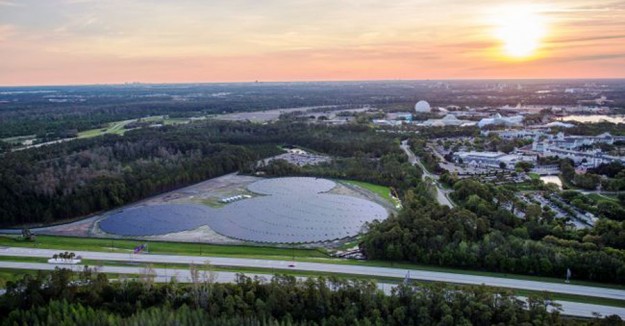
One of the most exciting things about advanced energy is its promise for the future. Yes, advanced energy is revolutionizing the way we generate, transmit, and use energy today, and some forms have been in use for thousands of years (check out Wikipedia’s entry on early river-based hydropower systems), but the promise of future technology is enough to get any red-blooded American excited. Well, this red-blooded American, anyway. From new ways to get power from the ocean to small-scale nuclear energy to a solar array fit for any Mouseketeer’s clubhouse, come with us to a journey to Tomorrowland.
Do you remember the feeling you got the first time you learned about the law of conservation of energy? That, if energy was never lost, simply transferred, the entire world is just made up of unlimited opportunity? That must be the feeling that Oscilla Power’s engineers get when they go to the beach. The ocean’s vast potential energy, that most alluring of renewable energy resources, has remained mostly lost to us. Thanks to our reliance on moving parts, the ocean’s energy has proved too powerful, destroying many a turbine left to collect power. Oscilla Power may have found a solution.
In an article (and accompanying video) entitled “This Device Could Provide a Third of America’s Power,” Bloomberg examines the technology that makes Oscilla Power different from other ocean power generators. Oscilla’s Triton, a device that collects and stores the ocean’s energy, works by applying the kinetic energy to a solid piece of metal, which creates an alternating magnetic polarity, which in turn can be turned into transmittable electricity. That said, as Sam Grobart says in the video, “wave is the Wild West of energy.”
Eliminating moving parts may prove to be the silver bullet the industry’s been looking for. But it will be hard to tell without a proper testing facility, which is a problem the Marine Renewable Energy Collaborative plans to solve. Writing for the Boston Globe (subscription required), Steve Mass reports on the testing facility being built by the Collaborative in the Cape Cod Canal, which will be the nation’s first permanent testing site for ocean power prototypes.
“There is no standard test for turbines, making it hard for generating venture capital,” said the Collaborative’s director, John Miller, adding that about 70% of the cost of an ocean demonstration was just in permitting. Will the presence of a permanent testing ground prove to be just what the industry needs to get to a design standard? Here’s hoping that a rising tide will lift all turbines (or, as the case may be, alternating magnetic polarity kinetic energy collectors).
Turning to a more landlocked energy source, this month the Tennessee Valley Authority (TVA) is seeking permission from the Nuclear Regulatory Commission (NRC) to locate “two or more” small modular reactors (SMRs) on a site first slated for nuclear power in the 1970s. America’s atomic-power age came to a grinding halt after Three Mile Island, with no new added capacity in more than three decades. That said, innovation in nuclear technology didn’t stop completely.
Next generation reactors, SMRs, are small-footprint nuclear power plants that can be sized between 10 MW and 300 MW, can be assembled offsite, and delivered fully constructed. SMRs are smaller, simpler, and can be sited in more places than utility-scale nuclear plants. They generally have their reactors buried in the ground, away from weather hazards. These designs often use passive cooling systems that are not vulnerable to power outages, increasing the safety of the plant. And one type of SMR has been in use and keeping people safe for decades – on submarines. Last summer, Third Way released a report that dozens of investors, ranging from AEE member Lockheed Martin to Bill Gates, have pooled more than $1.3 billion behind SMRs as cheaper, safer, more scalable successors to the big nuclear plants of old.
Still, TVA is not exactly rushing into SMR deployment. “We’re focused on providing an option that provides reliable, affordable and carbon-free energy, and so we want to pursue this early site permit to give us the option for possibly locating SMRs on the site for 10 to 20 years,” TVA spokesman Dan Stout told the Chattanooga Times Free Press.
Meanwhile, NuScale Power, an Oregon-based SMR company, is developing a site on the grounds of the Idaho National Laboratory, while simultaneously planning to submit an application for design certification to the NRC later this year. NuScale’s Chief Commercial Officer, Mike McGough, expects the plant to be “commercially operational” in 2024. “I know that is eight years from now,” McGough said in an interview with KUOW. “That seems like a long time, but in the space of what we're doing in the technology development and deployment, it's actually quite short.”
Finally, Duke Energy’s new solar farm in Central Florida might inspire song… the Mickey Mouse Club theme song, that is. The 48,000 solar panels, arranged in the shape of Mickey’s head, will power Walt Disney World Resort and several other hotels near Walt Disney World. The Sunshine State is ranked third in the nation for solar potential but is only number 13 in installations. That might all change soon, but it’s time for us at Advanced Energy Perspectives to say goodbye to friends and family with a song. I’ve only taken a few liberties:
M-I-C -- see an uptick in solar installations pretty soon!
K-E-Y – near the Florida Keys and elsewhere in the state!
(Sing it with me, now) Advanced Energy.